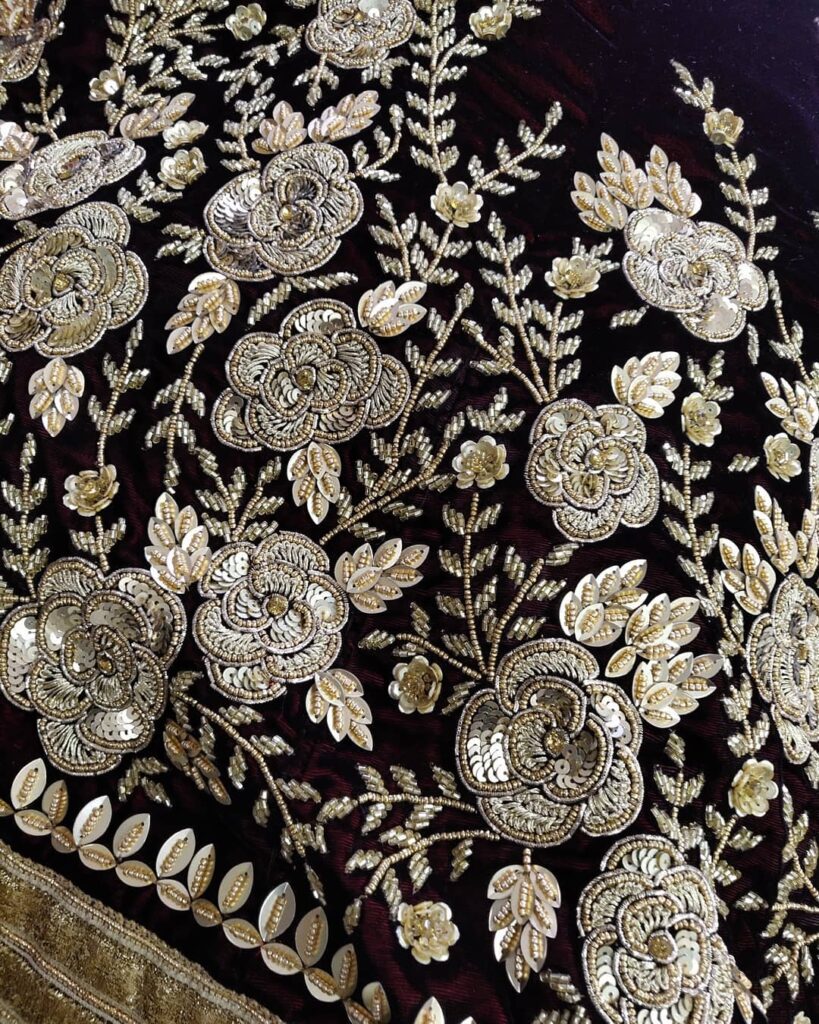
Zardozi is regarded across the globe as the most exquisite style of embroidered art, once reserved solely for the royals. Zardozi is a magnificent Indian-Iranian embroidered technique that historically graced the livery of kings. Zardozi is derived from two Persian terms, zar which means “gold” and dozi means “to stitch”.
Zardozi embroidery is well titled since it entails heavy and elaborate metal stitching on a foundation fabric composed of silk, satin, or velvet. The designs are created with gold and silver thread and often precious stones, beads, pearls and other decorative elements are added. Although traditionally real silver and gold thread were used for zardozi fabric, today, craftsmen tend to use copper wires with silver and gold varnishes along with silk thread instead. While this is owing to the scarcity of significant quantities of silver and gold thread, it has also increased the availability of Zardozi fabrics. Zardozi fabric may be used in a variety of applications, including apparel, home textiles, and animal trappings. Historically, it was employed to adorn the aristocracy’s possessions. In the exquisite Zardozi style, the royal tents, hangings, scabbards, and even the drapery of the royal elephants and horses were embroidered. Now, let’s trace the history of this great and unique creation of art.

The Rig Veda is the oldest known example of its use of gold embroidery in India. This suggests that gold embroidery has been practised for around 3500 years in India. Zardoz were people who worked with precious metals and stones to embroider them into cloth. Zardozi cloth was utilised in everything from regal attire to adornment of God’s statues. The Mughal Emperor, Akbar’s reign in the 17th century was the most profitable period for gold embroidery. However, as a result of the loss of royal sponsorship during the reign of Mughal Emperor Aurangzeb, the popularity of gold embroidery began to diminish. Craftsmen were unable to continue their work as raw resources became scarcer and more costly.
Delhi, which had been a centre of Zardozi craft, quickly bade goodbye to many of the artisans as they relocated to Punjab and Rajasthan to pursue work. Zardozi craft suffered another setback as a result of industrialization and the unattainable pace set by factory-made cloth. However, with India’s freedom, came a revival of all indigenous art and skill. Zardozi embroidery demonstrated itself to be no different. The Indian government took steps to promote it and it was steadily able to gain prominence in the Indian cities of Lucknow, Hyderabad, Farrukhabad, Chennai and Bhopal.
Methods of Zardozi
The artisans begin the Zardosi stitching technique by sitting cross-legged around the Addaa, the wooden framework, with their equipment. Curved hooks, needles, gold wires, sitaras (metal stars), round-sequins, glass and plastic beads, dabka (thread), and kasab are among the tools (thread) used. The second stage in the technique is to trace the pattern on the material, preferably silk, satin, or velvet. After stretching the cloth over the wooden frame, the embroidery process begins. Each zardosi motif is extracted with a needle and then incorporated into the fundamental pattern by inserting the needle into the cloth.

Zardozi needlework is an important component of Iranian culture as well. It is predominantly found in Hormozgan Province, with particular popularity in the cities of Minab, Bandar-e-Lengeh, and Bandar Abbas.
Although Iranian Zardozi, like Indian Zardozi, has limitless varieties, there are three basic types. In the first type, the foundation cloth is totally sewed with sutures to create unusual designs and colours. The design of the second kind is less dense. The strings are crossed across the cloth repeatedly to form a latticework-like motif. The last approach is most reminiscent of Indian handiwork, with patterns embroidered into the cloth using gold and silver strings. Zardozi needlework is becoming popular all over the world. Zardozi embroidery is now popular around the world, particularly in the United States, Australia, the United Kingdom, Dubai, Canada, and Middle Eastern countries. It is used to ornament both garments and accessories like salwar suits, lehengas, and other traditional attires. Zardozi designs are frequently influenced by and resemble natural themes such as floral patterns. Zardozi art is a jewel in the crown of India when it comes to stunning indigenous artwork. Once only patronised by the royals, today, Zardozi work can be worn by anyone on any occasion. Although the centres of Zardozi in and around Lucknow are thriving, it falls on us to keep the art form alive and make sure that it spreads all over India. Give yourself and your home an ethnic makeover with zardozi embroidered artefacts and costumes for a touch of royal elegance.


Sanjay Yadav
Sanjay Yadav is a MBA-RD professional by education. He has completed his education in Bachelor of science with PCM from Ewing Christian College(AU. He is an avid reader and loves to play online games in his free time.

